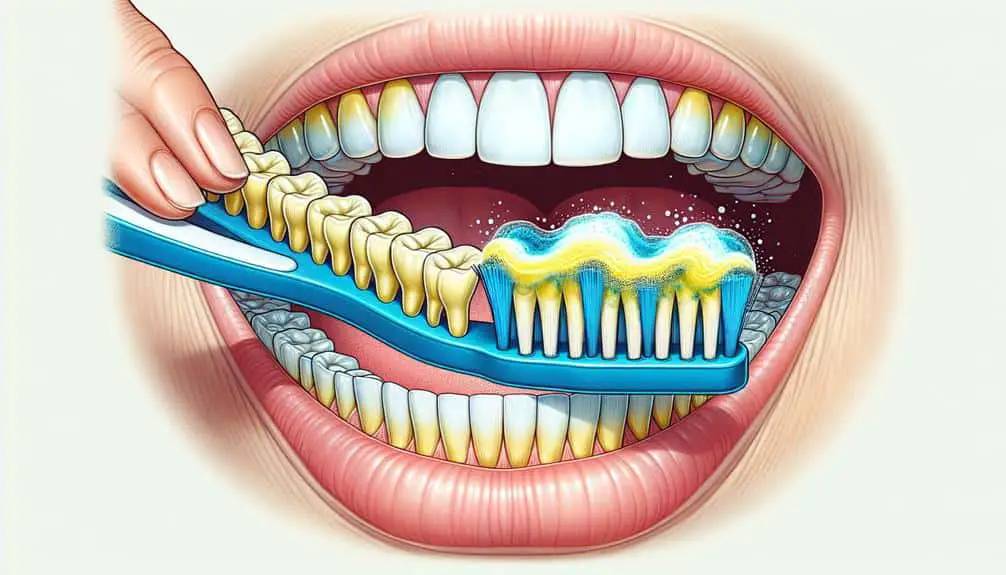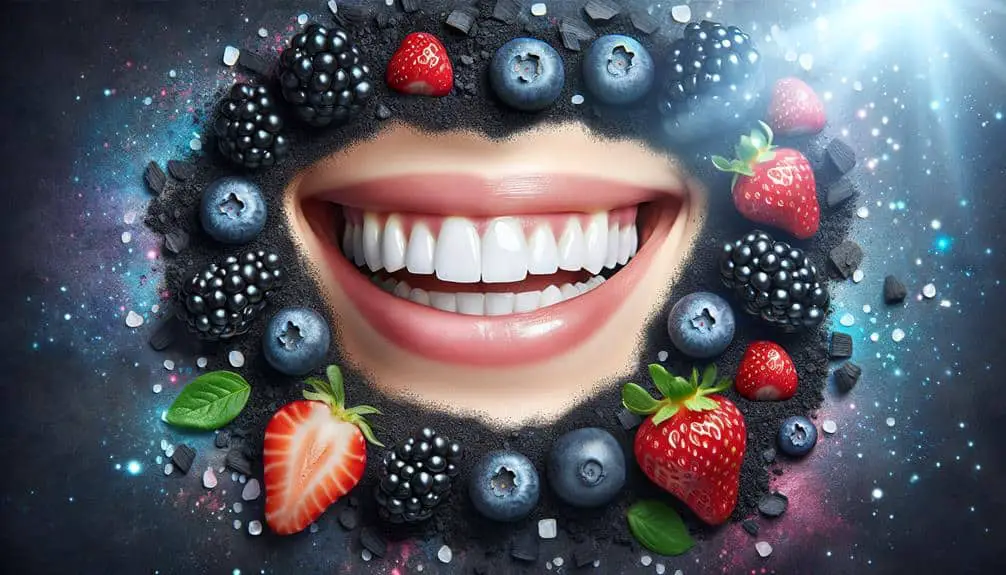Achieve effective whitening for fluoride-stained teeth at home with this DIY guide. Create a whitening toothpaste using baking soda, hydrogen peroxide, and peppermint oil. Implement natural remedies like sage and DIY mouthwashes for stain reduction. Prevent fluoride stains by monitoring fluoride exposure and using proper oral care techniques. Safely whiten teeth by consulting a dentist, following product instructions, and maintaining regular oral hygiene. These tips will help you brighten your smile.
Key Points
- DIY toothpaste with baking soda and hydrogen peroxide aids in whitening.
- Natural remedies like herbal mouthwashes can reduce fluoride stains.
- Monitor fluoride intake from various sources for preventive measures.
- Consult dentist before using DIY methods for stained teeth.
- Maintain safe whitening practices to protect enamel and gums.
Causes of Fluoride Stains
Fluoride stains on teeth are primarily caused by prolonged exposure to high levels of fluoride during tooth development, leading to discoloration that can be difficult to remove. This condition is known as dental fluorosis. When a child ingests too much fluoride, especially during the formative years of tooth growth, it can disrupt the enamel formation process. This disruption can result in the appearance of white or brown spots on the teeth, affecting their overall aesthetics.
Excessive fluoride exposure can occur through various sources such as fluoride supplements, certain types of toothpaste, or naturally high fluoride levels in water. It's essential to monitor fluoride intake, especially in children, to prevent the development of fluorosis.
Once dental fluorosis occurs, it may require professional treatments like teeth whitening procedures or dental bonding to improve the appearance of the affected teeth. Understanding the causes of fluoride stains is vital in taking preventive measures and maintaining peak oral health.
DIY Whitening Toothpaste Recipe
Creating your own whitening toothpaste at home can be a cost-effective and simple way to enhance the brightness of your smile. Homemade solutions offer DIY alternatives to commercial whitening toothpaste, allowing you to customize the ingredients to suit your specific needs.
To make your DIY whitening toothpaste, start with a base of baking soda, known for its mild abrasive properties that help remove surface stains. Add hydrogen peroxide, a common whitening agent, in small amounts to avoid irritation. You can also include a few drops of peppermint oil for a fresh taste and antibacterial properties. Mix these ingredients thoroughly to form a paste-like consistency.
Remember to use this toothpaste sparingly, as excessive use can erode tooth enamel. While DIY whitening toothpaste can help brighten your teeth, it's crucial to consult with your dentist before using it regularly to make sure it's safe for your individual oral health needs.
Natural Remedies for Stained Teeth
To naturally tackle teeth stains, consider incorporating effective remedies into your daily oral care routine. Herbal remedies have been used for centuries to combat teeth discoloration. For example, rubbing a small amount of sage or peppermint oil directly onto your teeth can help reduce stains and freshen your breath.
DIY mouthwashes can also be powerful allies in the fight against stained teeth. A simple mix of equal parts hydrogen peroxide and water can act as a potent mouthwash, helping to whiten teeth and kill bacteria that contribute to staining. Swish this solution around your mouth for about 30 seconds before spitting it out.
Another effective DIY mouthwash involves combining baking soda with water to create a paste. Gently brush this paste onto your teeth, allowing it to sit for a couple of minutes before rinsing thoroughly. The mild abrasiveness of baking soda helps to scrub away surface stains, revealing a brighter smile over time. Incorporating these herbal remedies and DIY mouthwashes into your oral care routine can assist in naturally combatting teeth stains.
Tips for Preventing Fluoride Stains
Preventing stains from fluoride on your teeth requires proactive oral care habits and mindful choices in your daily routine. To minimize the risk of fluoride stains, consider taking preventive measures such as monitoring your fluoride exposure. Fluoride is commonly found in toothpaste, mouth rinses, and even tap water, so it's crucial to be aware of how much fluoride you're coming into contact with.
One effective way to prevent fluoride stains is by using a pea-sized amount of fluoride toothpaste when brushing your teeth. This helps maintain the right balance of fluoride for dental health without overexposure. Additionally, consider using a fluoride-free toothpaste for children under six years old to prevent excessive fluoride intake during their developmental years.
Another preventive measure is to drink fluoridated water in moderation and be mindful of other sources of fluoride in your diet. By being conscious of your fluoride exposure and practicing good oral hygiene, you can reduce the likelihood of developing unsightly fluoride stains on your teeth.
Best Practices for Safe Whitening
For safe and effective teeth whitening, it's essential to follow best practices that prioritize the health and appearance of your smile. Precautionary measures are vital before starting any whitening treatment. Consult with your dentist to confirm your teeth and gums are healthy before proceeding. Effective techniques involve using whitening products as directed to avoid potential damage to your enamel or gums. It's important to choose reputable products and follow the instructions carefully.
When whitening your teeth, consider using products with lower concentrations of bleaching agents to minimize sensitivity. Additionally, spacing out treatments and avoiding excessive whitening can help maintain the health of your teeth. Remember to brush and floss regularly to remove any plaque or bacteria that could interfere with the whitening process.
To further protect your teeth, consider using a desensitizing toothpaste or gel recommended by your dentist. These products can help alleviate any sensitivity that may occur during or after whitening. By following these precautionary measures and effective techniques, you can safely achieve a brighter, whiter smile.
Frequently Asked Questions
Are Fluoride-Stained Teeth More Prone to Cavities and Decay?
Fluoride-stained teeth can be more prone to cavities and decay due to the mineral's excessive presence weakening enamel. To uphold excellent dental health, guarantee proper oral hygiene practices and consult a dentist for enamel protection strategies.
Can Fluoride Stains Be Completely Removed With DIY Whitening Methods?
You can achieve significant results with DIY whitening methods, but professional treatments offer greater effectiveness. Consider long-term benefits when choosing between cost-effective options. Understand that complete removal of fluoride stains may require professional intervention for best results.
How Long Does It Typically Take to See Results From Natural Remedies for Stained Teeth?
When using natural remedies for stained teeth, the teeth whitening timeline can vary. Results from home remedies may be visible in as little as a few weeks or may take a few months for significant progress.
Is It Possible to Prevent Fluoride Stains From Recurring After Whitening?
To prevent fluoride stains from recurring after whitening, incorporating long-term maintenance is key. Consistent use of fluoride-free toothpaste and regular dental cleanings can help maintain your bright smile. Stay proactive in your oral care routine.
Are There Any Specific Foods or Drinks That Should Be Avoided to Prevent Further Staining of Teeth?
To maintain your teeth's brightness, avoid stain-causing beverages like coffee, tea, and red wine. Be mindful of your dietary habits by limiting sugary and acidic foods that can contribute to teeth staining. Consistent care is key.



